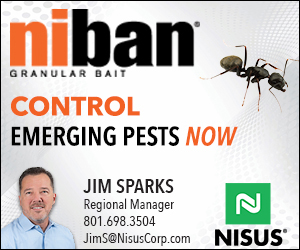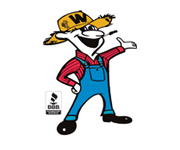September Board of Directors Meeting — IN PERSON
Our first in person meeting since COVID! We will have our first in person meeting at The Carlsbad Westin. The schedule below is tentative and may change (the dates will stay the same):
Thursday, September 23
Golf Tournament — 1:00 pm Tee Off
Aviara Golf Club, Carlsbad
$199/golfer
$250/tee sponsor
Registration for golf and sponsorships will be released in July
Friday, September 24
Committee Meetings — 8:00 am to 12:00 pm
Board of Directors Meeting — 1:00 pm to 4:00 pm
Reception and Awards — 5:30 pm to 7:30 pm
Room reservation links and more information will come out soon! We are so excited to meet up in person again and hope that you can all join us!


Looking Forward...
December BOD Meeting
December 9-10, 2021
Hilton — Palm Springs
Golf — Course TBD — Dec. 9
Committees & BOD — Dec. 10
PestEd Series Dates & Locations TBD
Termite Academy Dates TBD
April BOD Meeting & Legislative Day
March 7-9, 2022
Hyatt Regency — Sacramento
Golf — Course TBD — Mar. 7
Committees & BOD — Mar. 8
Leg Day Event — Mar. 9
2022 Expo 2022
June 8-10, 2022
Disneyland Hotel — Anaheim
Schedule TBD

These are sure different times we are living in, but the good news is our economy is opening up again! I know a lot of you have already made your reservations for our Board of Directors meeting in Carlsbad in September but for those of you who haven’t, please join us on September 23rd and 24th! This won’t be a traditional Board Meeting because we’ll have sponsors' tables and events, speakers and frankly a celebration of our industry! Look forward to seeing you all there!!!
Chris Reardon
PCOC Executive Vice President
chris@pcoc.org
(916) 372-4363


Slow Page Load Speed Directly Impacts Your Website Conversions
A customer’s experience with you is everything. Just as you focus on providing effective pest control solutions and personable service to develop positive customer relationships, Google does the same. Sifting through millions of websites and presenting top-quality options is their service.
The online user experience is key to a successful Website. Page load speed plays a critical role in that experience.
How Page Load Speed Affects User Behavior
We are an increasingly demanding society, which is demonstrated by the small timeframe users allot a desktop or mobile webpage to load. Below are some statistics that show a visitor's likelihood to "bounce", which means leave your Website without viewing any other pages or clicking any buttons.
As a page load time (in seconds) goes from:
- 1s to 3s, the probability of bounce increases by 32%
- 1s to 5s, the probability of bounce increases by 90%
- 1s to 6s, the probability of bounce increases by 106%
- 1s to 10s, the probability of bounce increases by 123%
Google’s ranking algorithm incorporated page load speed in 2010 on desktops and 2018 on mobile. As of June 16, 2021, Google is in the process of rolling out their Page Experience Update, which will be completed by the end of August 2021. This Google Search update includes page loading speed, focusing in on when the Largest Contentful Paint (LCP) loads. LCP is one of three qualifications making up the new Core Web Vitals report (CWV). If a URL’s CWV report has a “Poor” or “Needs Improvement” status, that is considered Failed criteria under Google Search’s ranking algorithm.
The idea behind all these ranking updates is Google wants to provide every online user with the fastest online experience. Similar to you not offering a particularly hazardous pesticide or not recommending certain types of pest control methods you know will leave customers with reoccurring pest problems, Google will leave you behind in search rankings if your website is too slow.
What is Defined as “Slow” for Page Load Speeds?
According to Google, a page that is “very slow” takes longer than 10 seconds to fully load, but Google Search actually prefers a Website to load in under 3 seconds to be considered “quick.”
With the active rollout of the CWV report, you now must consider Largest Contentful Paint (LCP) as a factor. LCP is a user-friendly metric for measuring loading performance and is marked at the point when a page’s main content has loaded.
To find out how your pest control website measures up, Google PageSpeed Insights is a free tool that can provide you with metrics as well as suggestions for how to lower your page load time. Speaking of…
Hot Weather Alert

Employers are responsible for providing workplaces that are safe from excessive heat. Yet every year, thousands of workers become sick from exposure to heat, and some even die. Heat illnesses and deaths are preventable.
The risk of heat-related illnesses and deaths increases during warm summer months; humidity increases the risk. Heat stroke is the most serious heat-related illness. It occurs when the body becomes unable to control its temperature: body temperature rises rapidly, the sweating mechanism fails, and the body is unable to cool down. Body temperature may rise to 106°F or higher within 10 to 15 minutes. Heat stroke can cause death or permanent disability if emergency treatment is not provided.
Warning signs of heat stroke vary but may include:
- Extremely high body temperature (above 103°F)
- Red, hot, and dry skin (no sweating)
- Rapid, strong pulse
- Throbbing headache
- Dizziness
- Nausea
- Confusion
- Unconsciousness
How can heat illness be prevented?
Employers should establish a complete heat illness prevention program to prevent heat illness. This includes: provide workers with water, rest and shade; gradually increase workloads and allow more frequent breaks for new workers or workers who have been away for a week or more to build a tolerance for working in the heat (acclimatization); modify work schedules as necessary; plan for emergencies and train workers about the symptoms of heat-related illnesses and their prevention; and monitor workers for signs of illness. Workers new to the heat or those who have been away from work and are returning can be most vulnerable to heat stress and they must be acclimatized.
To prevent heat-related illness and fatalities:
- Drink water every 15 minutes, even if you are not thirsty.
- Rest in the shade to cool down.
- Wear a hat and light-colored clothing.
- Learn the signs of heat illness and what to do in an emergency.
- Keep an eye on fellow workers.
- “Easy does it” on your first days of work in the heat. You need to get used to it.
If workers are new to working in the heat or returning from more than a week off, and for all workers on the first day of a sudden heat wave, implement a work schedule to allow them to get used to the heat gradually. Working in full sunlight can increase heat index values by 15 degrees Fahrenheit. Keep this in mind and plan additional precautions for working in these conditions.
Remember these three simple words: Water, Rest, Shade. Taking these precautions can mean the difference between life and death.
For more information or help, contact the Insurance professionals of the PCOC Insurance Program. Call us at: 877.860.7378.
Paul Lindsay
Senior Vice President, Principal, Programs
EPIC Program Solutions
10877 White Rock Rd. Suite 300 Rancho Cordova, Ca 95670
paul.lindsay@epicbrokers.com
916.576.1545 direct | 877.222.0000 | 916.952.1609 cell
epicbrokers.com | ca license 0B29370
How Can Page Load Speed Be Improved?
You may find it more helpful (or less of a hassle) to have a professional Web developer decrease your load speed, but there are 3 simple strategies you can employ to speed your pest control site up a bit:
1. Optimize Your Photos
High-quality images, photo galleries, and pest ID indexes significantly help pest control businesses show off their industry expertise, but too much image quality and detail is possible. The larger (and clearer) the image is, the larger the file, which takes more time to download. Find a middle ground where the photo is sized correctly and compressed but is still visually appealing with quality resolution.
Now optimization comes in! Use your favorite photo editing software, or a free online service, to resize or scale down the file size of your Website’s images. Optimizing photos is an excellent starting point to speeding up your load time.
2. Keep Your Layout Simple
Some business owners have long lists of Website features they’ve seen on other pest control sites that they would like included on their own. We’re big fans of creativity, but we often remind pest control businesses that simplicity is best when it comes to their Website design.
Every time you feature something like an interactive map, a rotating slideshow, or a video, you tack on an additional “request” that the Internet must make to display your Website. One or two features won’t hurt you by much, but too many can be a big risk. When putting together your Homepage, only identify the necessary information you want your visitors to see. You will prevent your page from becoming too busy and decrease the time a user must wait for your pest control site to load.
3. Make Sure Your Web Hosting Plan Still Meets Your Standards
Perhaps you’ve tried some of these strategies before, yet they haven’t worked. Your Web hosting plan (typically a yearly payment made to keep your site and its files on the Internet) should be the next area you examine. It’s possible you’ve added numerous pages, galleries, and other content that may be too much for your initial hosting plan. Make sure your hosting plan matches with what your pest control company looks like today.
You must be mindful of both your desktop and mobile load speeds to effectively retain prospects. If prospects are not staying on your site due to a long load speed, then what’s the point of all the digital marketing efforts you invest in to show on Page One of Google Search?
Market Hardware is happy to offer Web Marketing consultations — give us a call to learn more! Contact us today if you’re interested and want more information! You can email PCOC@markethardware.com or call (888) 381-6925.
Frequently Asked For Websites
|













